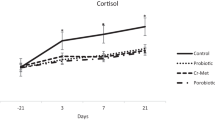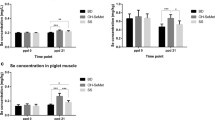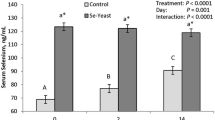Abstract
Previously, we reported that feeding selenium (Se)-enriched forage improves antibody titers in mature beef cows, and whole-blood Se concentrations and growth rates in weaned beef calves. Our current objective was to test whether beef calves fed Se-enriched alfalfa hay during the transition period between weaning and movement to a feedlot also have improved immune responses and slaughter weights. Recently weaned beef calves (n = 60) were fed an alfalfa-hay-based diet for 7 weeks, which was harvested from fields fertilized with sodium selenate at 0, 22.5, 45.0, or 89.9 g Se/ha. All calves were immunized with J-5 Escherichia coli bacterin. Serum was collected for antibody titers 2 weeks after the third immunization. Whole-blood neutrophils collected at 6 or 7 weeks were evaluated for total antioxidant potential, bacterial killing activity, and expression of genes associated with selenoproteins and innate immunity. Calves fed the highest versus the lowest level of Se-enriched alfalfa hay had higher antibody titers (P = 0.02), thioredoxin reductase-2 mRNA levels (P = 0.07), and a greater neutrophil total antioxidant potential (P = 0.10), whereas mRNA levels of interleukin-8 receptor (P = 0.02), l-selectin (P = 0.07), and thioredoxin reductase-1 (P = 0.07) were lower. In the feedlot, calves previously fed the highest-Se forage had lower mortality (P = 0.04) and greater slaughter weights (P = 0.02). Our results suggest that, in areas with low-forage Se concentrations, feeding beef calves Se-enriched alfalfa hay during the weaning transition period improves vaccination responses and subsequent growth and survival in the feedlot.


Similar content being viewed by others
Abbreviations
- ACTB:
-
Beta-actin
- ADG:
-
Average daily gain
- BIRC2:
-
Baculoviral IAP repeat-containing protein 2
- BP:
-
Base pairs
- BW:
-
Body weight
- CASP4:
-
Caspase 4
- CFU:
-
Colony-forming units
- CRE:
-
Copper-reducing equivalents
- Dio:
-
Iodothyronine deiodinases
- DMSO:
-
Dimethyl sulfoxide
- FBS:
-
Fetal bovine serum
- FDA:
-
Food and Drug Administration
- FOS:
-
FBJ murine osteosarcoma viral oncogene homolog or c-FOS, and a member of the activator protein-1 family
- GAPDH:
-
Glyceraldehyde-3-phosphate dehydrogenase
- GPx:
-
Glutathione peroxidases
- HBSS:
-
Hank’s balanced saline solution
- ICE:
-
Interleukin 1β converting enzyme
- IFN-γ:
-
Interferon-gamma
- IL-2:
-
Interleukin 2
- IL-8R:
-
Interleukin-8 receptor
- l-Sel:
-
l-Selectin
- MOI:
-
Multiplicity of infection
- NETs:
-
Neutrophil extracellular traps
- NFκB:
-
Nuclear factor kappa B
- PBS:
-
Phosphate-buffered saline
- PPM1A:
-
Protein phosphatase magnesium-dependent 1A
- qPCR:
-
Quantitative polymerase chain reaction
- RBC:
-
Red blood cells
- ROS:
-
Reactive oxygen species
- RPL19:
-
Ribosomal protein large subunit family member-19
- SDHA:
-
Succinate dehydrogenase complex, subunit A
- Se:
-
Selenium
- SeMet:
-
Selenomethionine
- SEP:
-
Selenoproteins
- TBK1:
-
TANK-binding kinase 1
- TLR4:
-
Toll-like receptor 4
- TMB:
-
3,3’,5,5’-Tetramethyl-benzidine
- TNF-α:
-
Tumor necrosis factor α
- TrxR:
-
Thioredoxin reductases
- WB:
-
Whole-blood
- YWHAZ:
-
Tyrosine 3-monoxygenase/tryptophan 5-monooxygenase activation protein, zeta polypeptide
References
Finch JM, Turner RJ (1996) Effects of selenium and vitamin E on the immune responses of domestic animals. Res Vet Sci 60(2):97–106
Swecker WS, Eversole DE, Thatcher CD, Blodgett DJ, Schurig GG, Meldrum JB (1989) Influence of supplemental selenium on humoral immune-responses in weaned beef-calves. Am J Vet Res 50(10):1760–1763
Enjalbert F (2009) The relationship between trace elements status and health in calves. Rev Med Vet-Toulouse 160(8–9):429–435
Hugejiletu H, Bobe G, Vorachek WR, Gorman ME, Mosher WD, Pirelli GJ, Hall JA (2013) Selenium supplementation alters gene expression profiles associated with innate immunity in whole-blood neutrophils of sheep. Biol Trace Elem Res 154(1):28–44. doi:10.1007/s12011-013-9716-6
Fairweather-Tait SJ, Collings R, Hurst R (2010) Selenium bioavailability: current knowledge and future research requirements. Am J Clin Nutr 91(5):1484S–1491S. doi:10.3945/ajcn.2010.28674J
Reeves MA, Hoffmann PR (2009) The human selenoproteome: recent insights into functions and regulation. Cell Mol Life Sci 66(15):2457–2478. doi:10.1007/s00018-009-0032-4
Bellinger FP, Raman AV, Reeves MA, Berry MJ (2009) Regulation and function of selenoproteins in human disease. Biochem J 422(1):11–22. doi:10.1042/BJ20090219
Cheng AWM, Bolognesi M, Kraus VB (2012) DIO2 modifies inflammatory responses in chondrocytes. Osteoarthr Cartil 20(5):440–445. doi:10.1016/j.joca.2012.02.006
Kim KH, Gao Y, Walder K, Collier GR, Skelton J, Kissebah AH (2007) SEPS1 protects RAW264.7 cells from pharmacological ER stress agent-induced apoptosis. Biochem Biophys Res Commun 354(1):127–132. doi:10.1016/j.bbrc.2006.12.183
Curran JE, Jowett JB, Elliott KS, Gao Y, Gluschenko K, Wang J, Abel Azim DM, Cai G, Mahaney MC, Comuzzie AG, Dyer TD, Walder KR, Zimmet P, MacCluer JW, Collier GR, Kissebah AH, Blangero J (2005) Genetic variation in selenoprotein S influences inflammatory response. Nat Genet 37(11):1234–1241. doi:10.1038/ng1655
Hall JA, Bobe G, Hunter JK, Vorachek WR, Stewart WC, Vanegas JA, Estill CT, Mosher WD, Pirelli GJ (2013) Effect of feeding selenium-fertilized alfalfa hay on performance of weaned beef calves. PLoS One 8(3):e58188. doi:10.1371/journal.pone.0058188
Broadley MR, White PJ, Bryson RJ, Meacham MC, Bowen HC, Johnson SE, Hawkesford MJ, McGrath SP, Zhao FJ, Breward N, Harriman M, Tucker M (2006) Biofortification of UK food crops with selenium. Proc Nutr Soc 65(2):169–181
Hall JA, Harwell AM, Van Saun RJ, Vorachek WR, Stewart WC, Galbraith ML, Hooper KJ, Hunter JK, Mosher WD, Pirelli GJ (2011) Agronomic biofortification with selenium: effects on whole blood selenium and humoral immunity in beef cattle. Anim Feed Sci Technol 164(3–4):184–190. doi:10.1016/j.anifeedsci.2011.01.009
Hall JA, Van Saun RJ, Nichols T, Mosher W, Pirelli G (2009) Comparison of selenium status in sheep after short-term exposure to high-selenium-fertilized forage or mineral supplement. Small Rumin Res 82(1):40–45. doi:10.1016/j.smallrumres.2009.01.010
Chaiyotwittayakun A, Burton JL, Weber PS, Kizilkaya K, Cardoso FF, Erskine RJ (2004) Hyperimmunization of steers with J5 Escherichia coli bacterin: effects on isotype-specific serum antibody responses and cross reactivity with heterogeneous gram-negative bacteria. J Dairy Sci 87(10):3375–3385. doi:10.3168/jds.S0022-0302(04)73473-6
Brinkmann V, Reichard U, Goosmann C, Fauler B, Uhlemann Y, Weiss DS, Weinrauch Y, Zychlinsky A (2004) Neutrophil extracellular traps kill bacteria. Science 303(5663):1532–1535. doi:10.1126/science.1092385
Brenner SL, Korn ED (1979) Substoichiometric concentrations of cytochalasin D inhibit actin polymerization. Additional evidence for an F-actin treadmill. J Biol Chem 254(20):9982–9985
Wang YQ, Puntenney SB, Burton JL, Forsberg NE (2009) Use of gene profiling to evaluate the effects of a feed additive on immune function in periparturient dairy cattle. J Anim Physiol Anim Nutr 93(1):66–75. doi:10.1111/j.1439-0396.2007.00780.x
Leutenegger CM, Alluwaimi AM, Smith WL, Perani L, Cullor JS (2000) Quantitation of bovine cytokine mRNA in milk cells of healthy cattle by real-time TaqMan polymerase chain reaction. Vet Immunol Immunopathol 77(3–4):275–287
Menzies M, Ingham A (2006) Identification and expression of Toll-like receptors 1–10 in selected bovine and ovine tissues. Vet Immunol Immunopathol 109(1–2):23–30. doi:10.1016/j.vetimm.2005.06.014
Alluwaimi AM (2000) Detection of IL-2 and IFN-gamma m RNA expression in bovine milk cells at the late stage of the lactation period with RT-PCR. Res Vet Sci 69(2):185–187. doi:10.1053/rvsc.2000.0411
Tajima S, Aida Y (2002) Mutant tax protein from bovine leukemia virus with enhanced ability to activate the expression of C-fos. J Virol 76(5):2557–2562
Bruzelius K, Hoac T, Sundler R, Onning G, Akesson B (2007) Occurrence of selenoprotein enzyme activities and mRNA in bovine mammary tissue. J Dairy Sci 90(2):918–927. doi:10.3168/jds.S0022-0302(07)71575-8
Lum GE, Rowntree JE, Bondioli KR, Southern LL, Williams CC (2009) The influence of dietary selenium on common indicators of selenium status and liver glutathione peroxidase-1 messenger ribonucleic acid. J Anim Sci 87(5):1739–1746. doi:10.2527/jas.2008-1417
Connor EE, Laiakis EC, Fernandes VM, Williams JL, Capuco AV (2005) Molecular cloning, expression and radiation hybrid mapping of the bovine deiodinase type II (DIO2) and deiodinase type III (DIO3) genes. Anim Genet 36(3):240–243. doi:10.1111/j.1365-2052.2005.01282.x
Brennan KM, Terry EN, Michal JJ, Kincaid RL, Johnson KA (2009) Body weight loss in beef cows: II. Increased antioxidant messenger ribonucleic acid levels in skeletal muscle but not erythrocyte antioxidant activity. J Anim Sci 87(9):2867–2873. doi:10.2527/jas.2008-1301
Garcia-Crespo D, Juste RA, Hurtado A (2005) Selection of ovine housekeeping genes for normalisation by real-time RT-PCR; analysis of PrP gene expression and genetic susceptibility to scrapie. BMC Vet Res 1:3. doi:10.1186/1746-6148-1-3
Panousis N, Roubies N, Karatzias H, Frydas S, Papasteriadis A (2001) Effect of selenium and vitamin E on antibody production by dairy cows vaccinated against Escherichia coli. Vet Rec 149(21):643–646
Swecker WS Jr, Thatcher CD, Eversole DE, Blodgett DJ, Schurig GG (1995) Effect of selenium supplementation on colostral IgG concentration in cows grazing selenium-deficient pastures and on postsuckle serum IgG concentration in their calves. Am J Vet Res 56(4):450–453
Awadeh FT, Kincaid RL, Johnson KA (1998) Effect of level and source of dietary selenium on concentrations of thyroid hormones and immunoglobulins in beef cows and calves. J Anim Sci 76(4):1204–1215
Stewart WC, Bobe G, Vorachek WR, Stang BV, Pirelli GJ, Mosher WD, Hall JA (2013) Organic and inorganic selenium: IV. Passive transfer of immunoglobulin from ewe to lamb. J Anim Sci 91(4):1791–1800. doi:10.2527/jas.2012-5377
Stabel JR, Reinhardt TA, Nonnecke BJ (1991) Effect of selenium and reducing agents on in vitro immunoglobulin M synthesis by bovine lymphocytes. J Dairy Sci 74(8):2501–2506. doi:10.3168/jds.S0022-0302(91)78427-0
Goldson AJ, Fairweather-Tait SJ, Armah CN, Bao Y, Broadley MR, Dainty JR, Furniss C, Hart DJ, Teucher B, Hurst R (2011) Effects of selenium supplementation on selenoprotein gene expression and response to influenza vaccine challenge: a randomised controlled trial. PLoS One 6(3):e14771. doi:10.1371/journal.pone.0014771
Buchanan JT, Simpson AJ, Aziz RK, Liu GY, Kristian SA, Kotb M, Feramisco J, Nizet V (2006) DNase expression allows the pathogen group A Streptococcus to escape killing in neutrophil extracellular traps. Curr Biol 16(4):396–400. doi:10.1016/j.cub.2005.12.039
Beiter K, Wartha F, Albiger B, Normark S, Zychlinsky A, Henriques-Normark B (2006) An endonuclease allows Streptococcus pneumoniae to escape from neutrophil extracellular traps. Curr Biol 16(4):401–407. doi:10.1016/j.cub.2006.01.056
Boyne R, Arthur JR (1979) Alterations of neutrophil function in selenium-deficient cattle. J Comp Pathol 89(1):151–158
Gyang EO, Stevens JB, Olson WG, Tsitsamis SD, Usenik EA (1984) Effects of selenium-vitamin E injection on bovine polymorphonucleated leukocytes phagocytosis and killing of Staphylococcus aureus. Am J Vet Res 45(1):175–177
Grasso PJ, Scholz RW, Erskine RJ, Eberhart RJ (1990) Phagocytosis, bactericidal activity, and oxidative metabolism of milk neutrophils from dairy cows fed selenium-supplemented and selenium-deficient diets. Am J Vet Res 51(2):269–274
Weiss WP, Hogan JS (2005) Effect of selenium source on selenium status, neutrophil function, and response to intramammary endotoxin challenge of dairy cows. J Dairy Sci 88(12):4366–4374. doi:10.3168/jds.S0022-0302(05)73123-4
Hogan JS, Weiss WP, Smith KL (1993) Role of vitamin E and selenium in host defense against mastitis. J Dairy Sci 76(9):2795–2803. doi:10.3168/jds.S0022-0302(93)77618-3
Hall JA, Sendek RL, Chinn RM, Bailey DP, Thonstad KN, Wang Y, Forsberg NE, Vorachek WR, Stang BV, Van Saun RJ, Bobe G (2011) Higher whole-blood selenium is associated with improved immune responses in footrot-affected sheep. Vet Res 42(1):99. doi:10.1186/1297-9716-42-99
Lee S, Takahashi I, Matsuzaka M, Yamai K, Danjo K, Kumagai T, Umeda T, Itai K, Nakaji S (2011) The relationship between serum selenium concentration and neutrophil function in peripheral blood. Biol Trace Elem Res 144(1–3):396–406. doi:10.1007/s12011-011-9108-8
Sunde RA, Raines AM (2011) Selenium regulation of the selenoprotein and nonselenoprotein transcriptomes in rodents. Adv Nutr 2(2):138–150. doi:10.3945/an.110.000240
Arner ES (2009) Focus on mammalian thioredoxin reductases—important selenoproteins with versatile functions. Biochim Biophys Acta 1790(6):495–526. doi:10.1016/j.bbagen.2009.01.014
McKenzie RC, Arthur JR, Beckett GJ (2002) Selenium and the regulation of cell signaling, growth, and survival: molecular and mechanistic aspects. Antioxid Redox Signal 4(2):339–351. doi:10.1089/152308602753666398
Sordillo LM, O’Boyle N, Gandy JC, Corl CM, Hamilton E (2007) Shifts in thioredoxin reductase activity and oxidant status in mononuclear cells obtained from transition dairy cattle. J Dairy Sci 90(3):1186–1192. doi:10.3168/jds.S0022-0302(07)71605-3
Aitken SL, Karcher EL, Rezamand P, Gandy JC, VandeHaar MJ, Capuco AV, Sordillo LM (2009) Evaluation of antioxidant and proinflammatory gene expression in bovine mammary tissue during the periparturient period. J Dairy Sci 92(2):589–598. doi:10.3168/jds.2008-1551
Rooke JA, Robinson JJ, Arthur JR (2004) Effects of vitamin E and selenium on the performance and immune status of ewes and lambs. J Agric Sci 142:253–262. doi:10.1017/S0021859604004368
Mitchell GB, Albright BN, Caswell JL (2003) Effect of interleukin-8 and granulocyte colony-stimulating factor on priming and activation of bovine neutrophils. Infect Immun 71(4):1643–1649
Jozsef L, Khreiss T, El Kebir D, Filep JG (2006) Activation of TLR-9 induces IL-8 secretion through peroxynitrite signaling in human neutrophils. J Immunol 176(2):1195–1202
Kettritz R, Gaido ML, Haller H, Luft FC, Jennette CJ, Falk RJ (1998) Interleukin-8 delays spontaneous and tumor necrosis factor-alpha-mediated apoptosis of human neutrophils. Kidney Int 53(1):84–91. doi:10.1046/j.1523-1755.1998.00741.x
Waddell TK, Fialkow L, Chan CK, Kishimoto TK, Downey GP (1995) Signaling functions of l-selectin. Enhancement of tyrosine phosphorylation and activation of MAP kinase. J Biol Chem 270(25):15403–15411
Elenkov IJ, Iezzoni DG, Daly A, Harris AG, Chrousos GP (2005) Cytokine dysregulation, inflammation and well-being. Neuroimmunomodulation 12(5):255–269. doi:10.1159/000087104
Zhang F, Yu W, Hargrove JL, Greenspan P, Dean RG, Taylor EW, Hartle DK (2002) Inhibition of TNF-alpha induced ICAM-1, VCAM-1 and E-selectin expression by selenium. Atherosclerosis 161(2):381–386
Droke EA, Loerch SC (1989) Effects of parenteral selenium and vitamin E on performance, health and humoral immune response of steers new to the feedlot environment. J Anim Sci 67(5):1350–1359
Acknowledgments
Funded in part by Animal Health and Disease Project Formula Funds and the Agricultural Research Foundation, Oregon State University, Corvallis, OR 97331–4802, USA (J.A. Hall, Principal Investigator). Appreciation is also expressed to KC Bare and Opal Springs Farms, LLC, Culver, Oregon, for precise Se application rates to alfalfa fields and growing the alfalfa hay for the conduct of these experiments.
Author information
Authors and Affiliations
Corresponding author
Rights and permissions
About this article
Cite this article
Hall, J.A., Bobe, G., Vorachek, W.R. et al. Effects of Feeding Selenium-Enriched Alfalfa Hay on Immunity and Health of Weaned Beef Calves. Biol Trace Elem Res 156, 96–110 (2013). https://doi.org/10.1007/s12011-013-9843-0
Received:
Accepted:
Published:
Issue Date:
DOI: https://doi.org/10.1007/s12011-013-9843-0




